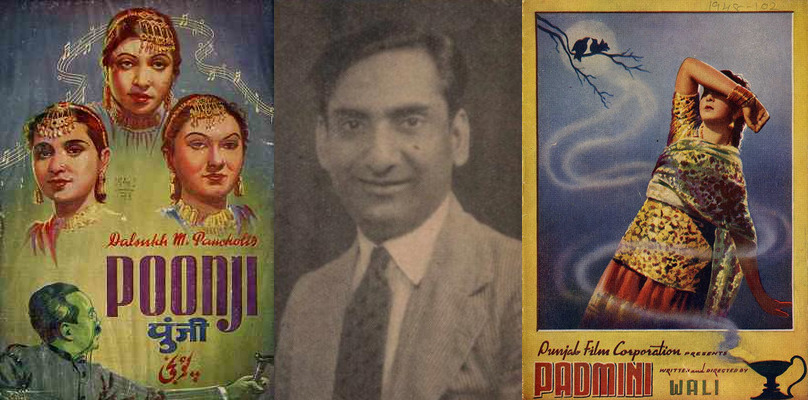Ghulam Haider revolutionalized the face of the Hindi Film song. He laid the foundation for the Hindi film song as we know it today by combining popular ragas with the rich verve and rhythm of Punjabi music.
‘Master ‘ Ghulam Haider was born in 1908 in Hyderabad in Sindh Province, now in Pakistan. Even as he studied dentistry, he also learnt music from Babu Ganeshlal. Giving up dentistry, he worked in the theatre in Calcutta as a harmonium player – first at the Alfred Theatrical Company and then the Alexandra Theatrical Company. He also briefly worked with the Jenaphone recording company as a composer and broke into films in Lahore with the father-son duo of Roshan Lal Shorey and Roop Kishore Shorey.
Haider achieved his big breakthrough film with DM Pancholi’s Punjabi film, Gul-e-Bakavali (1939), followed by Yamla Jat (1940), both starring Noor Jehan, with the latter film marking Pran’s debut as an actor.
Haider’s biggest hit came the following year with Khazanchi (1941). The music of the film, starring M Ismail, Ramola and SD Narang, caused a revolution, in particular, the song Sawan Ke Nazare Hain sung by Shamshad Begum and Haider himself. By then Music Directors of the 1930s, who had embellished films with their exquisite compositions set in classical ragas, were beginning to sound commonplace. Khazanchi’s refreshingly free-wheeling and rhythmic music not only took audiences by storm but also made other music directors sit up and take notice. With this film, Haidar ensured that the Indian film song would never be the same again.
Khandaan, the following year with Noor Jehan and Pran, was again a mega hit, establishing Haider at the very top. Amongst its very popular songs, the film is known for the classic Noor Jehan solos, Tu Kaunsi Badli Mein Mere Chand Hai Aaja and Hum Khelenge Aankh Micholi.
Following the success of Pancholi’s Poonji (1943), Haider moved to India’s film capital, Bombay, where he worked in films like Chal Chal Re Naujavaan (1944), the first ever film produced by the newly formed Filmistan Studio, Phool (1945), helmed by K Asif, and Mehboob Khan’s Humayun (1945). His best-known compositions were invariably sung by Shamshad Begum and strongly invoke Punjabi folk and extensively featured percussion instruments like the dholak. Naina Bhar Aaye Neer, sung so soulfully by Shamshad in Humayun, took the country by storm.
According to Haider, much of the popularity of a song would depend on its lyrics as well as the skill and style of the singer. As soon as he heard the voice of a singer, he composed a tune suited to that voice. It was essential to him that the singer convey the correct emotions that the scene demanded.
It was Haider who gave Lata Mangeshkar her first major break in Hindi films with Majboor (1948) and took her to S Mukerji to sing in Shaheed (1948), but Mukerji rejected her, saying her voice was too thin! Haider warned him that this ‘poor little thing’ would soon put every other singer in the shade, including Noor Jehan! He managed Shaheed with Geeta Dutt and another singer he introduced, Surinder Kaur, singing his compositions before giving Mangeshkar her first hit song, Dil Mera Toda from Majboor, a Bombay Talkies production starring Shyam and Munawar Sultana. Mangeshkar remained eternally grateful to Haider and always made it a point to mention his role in helping to shape her phenomenal career. She recalled how he fought producers for her and strived hard to make her move forward in the film industry at a time when she was facing rejection.
Shaheed, Padmini (1948) and Kaneez (1949) were among his last big hits in India. In the former, as patriotic songs go, who can forget Watan Ki Raah Mein Watan Ke Naujawan Shaheed Ho? The song was used thrice in the film, first in the opening credits, then at a brisk tempo to raise the morale of the revolutionaries and finally, slowly and solemnly as the revolutionary’s dead body is carried to the cremation ground at the end of the film. This was not only an early use of the happy and sad versions of the same song, but also utilizing the song as a leitmotif for a character in a film.
Music aside, Ghulam Haider was also responsible for raising the status of Music Directors. In those days, it is said that he demanded and got Rs 25,000 a film! It was a result of his efforts that musicians were given their due and paid better wages.
After the Partition, Haider returned to Lahore in 1949. His first film in Pakistan was Shahida (1949). He then composed music for films like Beqarar (1950), Akeli (1951) and Bheegi Palken (1952) across the border, but unfortunately for him, none of the films did particularly well. A song from Akeli, Aaye Khushi Ke Zamane, did find its ‘copy’ in India in the landmark Tamil film, Parasakthi (1952), as O Rasikkum Seemane. Haider also started a film production company in Lahore, Filmsaz, with director S Nazir Ajmeri and actor S Gul.
Gulnar (1953) reunited him with Noor Jehan and resulted in some great songs rendered beautifully by the Mallika-e-Tarannum, like Lo Chal Diye Hain Woh and Bachpan Ki Yaadgaron, but sadly, Haider could never replicate the kind of success that he experienced in India. He passed away in 1953, just days after the release of Gulnar. He had not been keeping and Lata Mangeshkar kept requesting him to come to India for treatment, but unfortunately, he couldn’t make it. Haider was barely 45 when he passed away.
Ghulam Haider’s success encouraged other Punjabi music directors to enter films. These included, among others, Shyam Sunder, Husnlal-Bhagatram, Feroz Nizami and Hansraj Behl. Today, Ghulam Haider’s name is almost forgotten. What remains are remnants of his great work and the works of others influenced by him.



Gem of an article
Thanks, Pankaj. Means a lot coming from you!